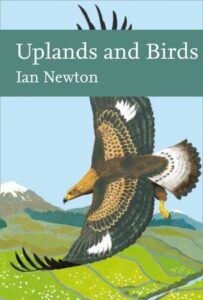 When it comes to the most prolific contributor of volumes to the monumental Collins New Naturalist Library series, by my reckoning the winner is Ian Newton OBE, FRS, FRSE. Beginning with Finches (vol. 55) in 1972, and continuing through Bird Migration (vol. 113), Bird Populations (vol. 124), and Farming and Birds (vol. 135), he has recently reached a remarkable fifth title contributed to the series with his newly published Uplands and Birds (vol. 142).
When it comes to the most prolific contributor of volumes to the monumental Collins New Naturalist Library series, by my reckoning the winner is Ian Newton OBE, FRS, FRSE. Beginning with Finches (vol. 55) in 1972, and continuing through Bird Migration (vol. 113), Bird Populations (vol. 124), and Farming and Birds (vol. 135), he has recently reached a remarkable fifth title contributed to the series with his newly published Uplands and Birds (vol. 142).
Effectively the lands in the U.K. above 300m in elevation, the uplands include such remarkable areas as the Brecon Beacons, the Pennines, and Dartmoor, as well as a number of other locations both well and less-popularly known. In fact, according to the RSPB, the uplands account for approximately 40% of the United Kingdom’s land area. They are also the source of a substantial amount of the drinking water for that island nation, as well as the sites of some of the most contentious disputes over land use and wildlife habitat preservation.
Focusing on these eco-regions’ birdlife – 142 breeding species in all, including grouse, raptors, and waders – Prof. Newton provides an extensive examination of the forces, both natural and commercial, that meet in the uplands and affect the lives of the many species that call these places their homes. Indeed, those who are particularly interested in the inter-relationships between birds and human activities in the uplands are recommended by the publisher to pair this most recently published book with Prof. Newton’s previous Farming and Birds – a combination that, by my estimation, would provide any reader with as thorough an explanation of that subject as one is likely to anywhere obtain.
It may take me a while to complete a thorough reading of Uplands and Birds 598 lavishly illustrated pages (I tend to linger over photographs of both wildlife as well as of picturesque landscapes), however once I do, I shall be certain to report back on my discoveries made therein.
